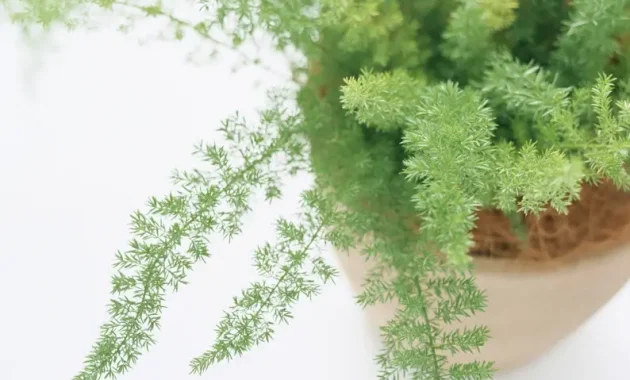If you are looking to add a touch of greenery to your home or office, asparagus ferns are an excellent choice. These delicate plants are known for their feathery foliage and charming appearance. However, like any other plant, asparagus ferns require proper care to flourish and stay healthy.
In this article, we will share with you some essential tips and tricks for caring for your asparagus ferns to ensure they thrive. We will cover everything from watering and lighting requirements to common issues that may arise, and how to propagate and repot your plants.
By the end of this guide, you will have all the knowledge and skills necessary to care for your asparagus ferns and keep them healthy and happy for years to come.
How to Care for Asparagus Ferns
Asparagus ferns are a popular choice among houseplant enthusiasts due to their delicate foliage and easy care requirements. These plants can thrive both indoors and outdoors, making them a versatile addition to any home or garden.
Proper care is crucial for ensuring a healthy and thriving asparagus fern. Here are some essential tips for maintaining your plant:
| Aspect | Care |
|---|---|
| Watering | Asparagus ferns require consistently moist soil, but are sensitive to overwatering. Water thoroughly when the top inch of soil is dry to the touch, and avoid letting the plant sit in standing water. During the winter months, reduce watering frequency to prevent root rot. |
| Lighting | Asparagus ferns prefer bright, indirect light but can tolerate some direct sunlight. Avoid placing them in full shade or direct sunlight, as they can burn easily. |
| Soil | Use a well-draining potting mix with plenty of organic matter, such as peat moss or compost. Asparagus ferns prefer slightly acidic soil with a pH of 5.5 to 6.5. |
| Pruning | Use clean, sharp scissors to remove any yellow or dead foliage, as well as any stems that are growing too long or becoming overcrowded. Pruning can help promote healthy growth and prevent disease. |
| Propagation | Asparagus ferns can be propagated through division or by planting stem cuttings in moist soil. Make sure each cutting has at least one node, and keep the soil moist until new growth appears. |
By following these tips and providing consistent care, your asparagus fern can thrive and add a touch of greenery to your home or garden year-round.
Watering Asparagus Ferns
Proper watering is crucial for the health of your asparagus fern. These plants have high moisture requirements, so it’s important to ensure they don’t dry out. However, overwatering can be just as harmful as underwatering, so it’s essential to strike the right balance.
How Often to Water
As a general rule, water your asparagus fern once a week. However, the frequency of watering may vary depending on the conditions in your environment. For example, in hot or dry climates, you may need to water more often.
It’s important to let the soil dry slightly between waterings to prevent overwatering. Stick a finger into the top inch of soil, and if it feels dry, it’s time to water. If it still feels damp, wait a day or two before checking again.
Signs of Overwatering or Underwatering
Overwatering can cause the roots to rot and lead to yellowing leaves. Underwatering, on the other hand, can cause the plant to wilt and the leaves to turn brown. If you notice any of these symptoms, adjust your watering routine accordingly.
Another sign of overwatering is the presence of standing water in the saucer beneath the pot. Make sure to empty any excess water to prevent root rot.
Best Practices for Watering
When watering your asparagus fern, make sure to saturate the soil completely. You may need to water more than once to achieve this. Allow the excess water to drain away, as standing water can lead to root rot.
It’s also a good idea to mist the fronds of your asparagus fern occasionally. This will help to maintain the humidity levels that these plants require to thrive.

Providing Adequate Lighting for Asparagus Ferns
Asparagus ferns require bright, indirect light to thrive. Placing them in a location with direct sunlight can scorch their delicate leaves, while too little light can cause stunted growth and yellowing foliage.
The ideal location for your asparagus fern is near a window with filtered light, such as a sheer curtain. If you live in a location where natural light is limited, you can provide artificial light by using fluorescent or LED grow lights. Place the lights a few feet above the plant and leave them on for 12-14 hours a day.
If you notice that your asparagus fern is leaning towards the light source, turn the pot every few days to encourage even growth.
In addition to proper lighting, it is important to keep your asparagus fern in a room with a consistent temperature range of 60-75°F (15-24°C). Avoid placing your plant in areas with extreme temperature fluctuations, such as near air conditioning vents or drafty windows.
Common Problems with Asparagus Ferns
Asparagus ferns are generally easy to care for, but like any plant, they can encounter issues. Here are some of the most common problems you may encounter when caring for your asparagus ferns and how to address them:
1. Pests
Asparagus ferns can be susceptible to pests such as spider mites and mealybugs. These pests can cause damage to the leaves and weaken the plant. To address this, regularly inspect your plant for signs of infestation. If you notice any pests, try wiping them off with a damp cloth or using an insecticidal soap to get rid of them. You can also try using natural remedies like neem oil.
2. Diseases
Fungal diseases such as root rot and leaf spot can affect asparagus ferns. To prevent these diseases, ensure that your plant is placed in well-draining soil and avoid overwatering. If you notice any signs of disease, such as yellowing or spotting on the leaves or moldy or mushy roots, remove the affected parts of the plant and treat with a fungicide if necessary.
3. Environmental Factors
Asparagus ferns can be sensitive to changes in their environment. For example, if the plant is exposed to drafts, it can cause the leaves to dry out and brown. To address this issue, ensure that your plant is placed in a location that is sheltered from drafts. Similarly, if the humidity is too low, the leaves can become dry and brown. To increase humidity, you can mist your plant or place a humidifier nearby.
4. Overcrowding
Over time, asparagus ferns can become overcrowded and start to compete for resources. This can lead to stunted growth and a weakened plant. To address this issue, consider repotting your plant into a larger container to give it more space and nutrients to grow.
By being aware of these common problems and taking steps to prevent and address them, you can help your asparagus fern thrive and stay healthy.
Repotting and Propagating Asparagus Ferns
As asparagus ferns grow, they will eventually outgrow their container and need to be repotted. Additionally, propagating new plants from existing ones is a great way to expand your collection or share with others.
When to Repot Asparagus Ferns
Experts recommend repotting asparagus ferns every two years, or when the roots begin to take up the majority of the container’s space. The best time to repot is in the spring or early summer, when the plant is actively growing and can more easily adjust to a new container and soil.
Choosing the Right Soil
When repotting asparagus ferns, it’s important to use a well-draining soil mix that’s rich in organic matter. A mixture of peat moss, perlite, and sand is ideal. Avoid using heavy soils or those that can retain too much water, as this can lead to root rot.
Propagating Asparagus Ferns
Propagating asparagus ferns is relatively easy and can be done through division or by taking stem cuttings. To propagate through division, gently remove the plant from its container and separate the root system into two or more sections, making sure each section has a good amount of foliage and roots. Replant each section in its own container with fresh soil.
To propagate by stem cuttings, take a cutting that is at least a few inches long and has a few leaves. Dip the cut end in rooting hormone and plant it into a container with moist soil. Keep the soil consistently moist and in a warm, bright location. After a few weeks, new growth should appear, indicating successful propagation.
Conclusion
With proper care and maintenance, asparagus ferns can be a beautiful and thriving addition to any indoor or outdoor space. By following these tips for repotting and propagating, you can ensure that your plant will continue to grow and flourish for years to come.


